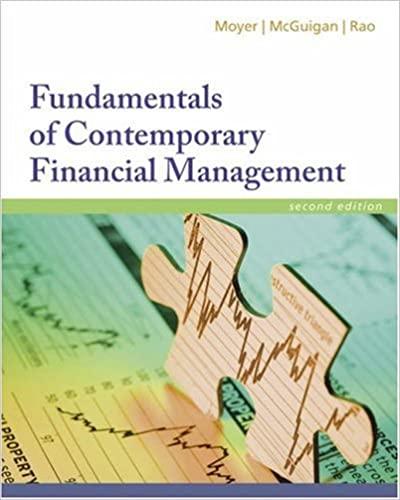Question
Problem 18-06 Refunding Analysis Jan Volk, financial manager of Green Sea Transport (GST), has been asked by her boss to review GST's outstanding debt issues
Problem 18-06 Refunding Analysis
Jan Volk, financial manager of Green Sea Transport (GST), has been asked by her boss to review GST's outstanding debt issues for possible bond refunding. Five years ago, GST issued $60,000,000 of 14%, 25-year debt. The issue, with semiannual coupons, is currently callable at a premium of 8%, or $80 for each $1,000 par value bond. Flotation costs on this issue were 4%, or $2,400,000.
Volk believes that GST could issue 20-year debt today with a coupon rate of 9%. The firm has placed many issues in the capital markets during the last 10 years, and its debt flotation costs are currently estimated to be 5% of the issue's value. GST's federal-plus-state tax rate is 35%.
Help Volk conduct the refunding analysis by answering the following questions.
Please answer all questions except for the last one (i).
A. What is the total dollar call premium required to call the old issue? $_____
Is it tax deductable? YES or NO
What is the net after-tax cost of the call? $ _____
B. What is the dollar flotation cost on the new issue?
$_______
Is it immediately tax deductible? Yes or No
What is the after-tax flotation cost?
$_______
C. What amount of old-issue flotation costs have not been expensed?
$_______
Can these deferred costs be expensed immediately if the old issue is refunded? -If the issue is refunded, the unexpensed portion of the flotation costs can or cannot be immediately expensed? (can or cannot)
What is the value of the tax savings? $ ______
D. What is the net after-tax cash outlay required to refund the old issue? $ ______
E. What is the semiannual tax savings that arises from amortizing the flotation costs on the new issue? $ ______ What is the forgone semiannual tax savings on the old-issue flotation costs? $ _______
F. What is the semiannual after-tax interest savings that would result from the refunding? $ ______
G. Thus far, Volk has identified two future cash flows: (1) the net of new-issue flotation cost tax savings and old-issue flotation cost tax savings that are lost if refunding occurs and (2) after-tax interest savings. What is the sum of these two semiannual cash flows? $ _______
What is the appropriate discount rate to apply to these future cash flows? Round your answer to two decimal places.
________ % per semiannual period
What is the present value? Round your answer to the nearest dollar. $ _____
H. What is the NPV of refunding? Round your answer to the nearest dollar. $ _______
Should GST refund now or wait until later?
I. Do not need. Thank you
Step by Step Solution
There are 3 Steps involved in it
Step: 1

Get Instant Access to Expert-Tailored Solutions
See step-by-step solutions with expert insights and AI powered tools for academic success
Step: 2

Step: 3

Ace Your Homework with AI
Get the answers you need in no time with our AI-driven, step-by-step assistance
Get Started


